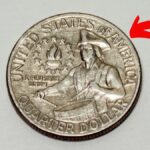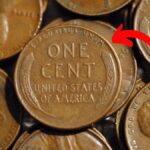The Lincoln Wheat Penny, minted from 1909 to 1958, is one of the most famous and valuable coins in U.S. history. Designed by Victor David Brenner, the penny features a portrait of President Abraham Lincoln on the front and two wheat stalks on the back. This design symbolizes America’s agricultural roots and the nation’s unity. While millions of these pennies were produced, some rare versions have become highly sought after by collectors, with one specific variant selling for up to $140,000 at auctions.
What Makes the Lincoln Wheat Penny Special?
The Lincoln Wheat Penny stands out because it was the first U.S. coin to feature a real person—Abraham Lincoln. Before this, coins mostly featured symbols or allegorical figures. This change marked a new era in American coinage. The reverse side of the penny, featuring two wheat stalks, reflects an agricultural economy, which was central to America’s prosperity during that time.
The design, while simple, carries a lot of historical weight. However, not all Lincoln Wheat Pennies are worth a fortune. The value of each penny depends on several factors, such as its year of minting, mint mark, condition, and any rare errors that may exist.
The $140,000 Lincoln Wheat Penny: A Rare Treasure
One of the most valuable Lincoln Wheat Pennies is the 1943 bronze penny. During World War II, the U.S. Mint switched from copper to steel to conserve copper for wartime needs. Most pennies minted in 1943 were made from zinc-coated steel. However, a few bronze blanks from previous years accidentally made it into the minting process, creating a rare version of the 1943 penny.
This mistake has turned into a highly valuable coin, with only about 20 of these 1943 bronze pennies known to exist today. As a result, these coins can fetch as much as $140,000 in auctions. Finding one of these rare pennies is like finding a hidden treasure!
Identifying a Valuable Lincoln Wheat Penny
Not all Lincoln Wheat Pennies are worth thousands of dollars, but some are worth more than others. If you think you have a valuable penny, there are a few things to look for:
Date and Mint Mark
Certain years and mint marks make a penny more valuable. For example, the 1909-S VDB penny, which features the designer’s initials on the reverse side, can be worth up to $2,000. Other years, like the 1914-D penny, minted in Denver, can also be worth around $1,500. If your penny is from one of these rare years, it could be a valuable find.
Material
The material of the penny can also affect its value. For example, the 1943 penny made of bronze instead of steel is exceptionally rare. The 1943 steel pennies are much more common, so the bronze ones are highly prized by collectors.
Condition
The condition of the penny plays a significant role in its value. Pennies in mint or uncirculated condition are worth much more than those that have been heavily worn. Even pennies that are in good condition, with minimal wear, can be worth more than the average penny.
Errors
Minting errors can make a coin even more valuable. For instance, a penny with a double die (where the design is struck twice) or other mistakes may be worth more to collectors. These errors are often what make certain pennies rare and highly valuable.
The Value of Other Lincoln Wheat Pennies
While the $140,000 1943 bronze penny is the most famous and valuable, other Lincoln Wheat Pennies can also fetch high prices. Here are a few examples:
- 1909-S VDB Penny: This penny is one of the most famous and valuable of all the Wheat Pennies. It can sell for up to $2,000, depending on its condition.
- 1914-D Penny: A penny minted in Denver in 1914 can be worth around $1,500 in good condition.
- Other Early Wheat Pennies: Even pennies from the early years, such as the 1911, 1912, and 1913 coins, can be worth more than regular pennies, especially if they are in good condition.
Still in Circulation: Finding a Rare Penny
What’s even more exciting is that some of these valuable Lincoln Wheat Pennies are still in circulation. Many people still come across these coins in their pocket change, without even realizing their worth. Coin collectors often recommend checking your pennies carefully, especially if they come from rolls of coins obtained at a bank. You never know when you might stumble upon a rare gem hiding in plain sight.
How to Preserve and Sell a Rare Penny
If you think you’ve found a valuable Lincoln Wheat Penny, it’s important to handle it carefully to avoid damaging it. Here are some tips on preserving and selling your rare penny:
Handle with Care
To keep your coin in good condition, avoid touching the surface with your bare hands. The oils and dirt from your skin can cause damage over time. Instead, wear gloves or hold the coin by the edges to prevent fingerprints.
Authenticate the Coin
To ensure your penny is truly valuable, consider having it authenticated by a professional. Numismatists, or coin experts, can evaluate your coin and give you an accurate appraisal. You can also send the coin to a reputable grading service, such as PCGS or NGC, to get it professionally graded.
Store Properly
To protect your rare penny, store it in a protective holder or case. This will help preserve its condition and prevent any further damage.
Sell Wisely
If you decide to sell your coin, consider using auction houses, online marketplaces, or coin dealers. Research the best places to sell your coin and make sure you get the best price.
Conclusion: The Thrill of Coin Collecting
The Lincoln Wheat Penny is more than just a piece of currency; it’s a part of American history. With rare versions worth up to $140,000, the Lincoln Wheat Penny continues to capture the imagination of collectors and history enthusiasts alike. Whether you’re a seasoned coin collector or just starting, the excitement of finding a rare penny in your change is a thrilling experience. So, keep an eye out for those hidden treasures—they might just be waiting for you!
Disclaimer: The value of coins can fluctuate over time based on market conditions. Always consult a professional numismatist for accurate appraisals and advice.






